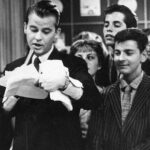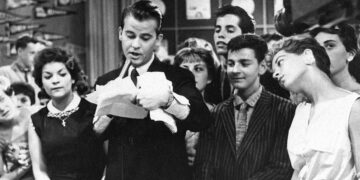

In a Pontiac advertisement that aired just before the 1969 episode of American Bandstand above, the year’s models are touted as “breakaway cars” — vehicles for escape without rebellion. The ad shows a handful of getaways, all ending at the dealership, presided over by a bland salesman who smiles and nods his approval. It’s an apposite choice for the program that follows — a show which, for 37 years, gave American audiences safe teenage rebellion in the wholesome container of Dick Clark’s fictional 50s record shop.
As the episode opens, the camera pans around the bodies of teenage dancers, as if they were this year’s newest models, then lands on the smiling, square-jawed Clark, the seemingly ageless host who gave approval to the proceedings for the folks back home. What was he selling?
Viewers could consume the latest dance trends and pop hits in their living rooms, then journey to the local record shop — just like the one on set! The show’s reach was huge, and most every artist who made an appearance crossed over into mainstream success.
American Bandstand began its life in 1952 on a local ABC affiliate station in Philadelphia. Then it was called Bandstand and its hosts were radio personality Bob Horn and former ad salesman Lee Stewart, whom, it was thought, “could bring some of his clients on board as advertisers,” as Steve Cohen writes at the Cultural Critic. “Stewart had no charisma and eventually was dropped from the program.” Horn continued until 1956, when he was fired from the show after a drunk-driving arrest. The show’s wholesome image belied sordid beginnings.
Clark joined at the young age of 26 to replace Horn, the hard-drinking, chain-smoking 40-year-old. Establishing an easy rapport with the show’s young dancers, who came from the local West Philadelphia Neighborhood, Clark helped return Bandstand to respectability, then pushed for it to go national, which it did in 1957, “beaming images of clean-cut, average teenagers,” notes History.com, “dancing to the not-so-clean-cut Jerry Lee Lewis’ ‘Whole Lotta Shakin’ Goin’ On’ to 67 ABC affiliates across the nation.” (A grossly ironic musical choice.)
Renamed American Bandstand, the newly national program featured a number of new elements that became part of its trademark, including the high school gym-like bleachers and the famous segment in which teenage studio guests rated the newest records on a scale from 25 to 98 and offered such criticisms as “It’s got a good beat, and you can dance to it.” But the heart of American Bandstand always remained the sound of the day’s most popular music combined with the sight of the show’s unpolished teen “regulars” dancing and showing off the latest fashions in clothing and hairstyles.
Four years after becoming the show’s host, Clark became a millionaire at age 30. Hauled before Congress in 1960 to answer payola charges, he admitted to taking a few bribes, promised to divest, and skated away on charm while a business partner confessed and resigned. At the time, he described himself as “having an interest in 33 businesses,” Becky Krystal writes at The Washington Post, “ranging from music publishers to, as The New York Times reported, an operation that made and sold a stuffed kitten for sale on American Bandstand called the Platter-Puss.” His business model was decades ahead of the industry.
“A man with an unerring sense of what Americans wanted to hear and see,” Krystal writes (or a sense of who to ask), Clark “achieved his greatest renown for an ability to connect with the taste of the post-World War II baby-boom generation. By the show’s 30th anniversary, almost 600,000 teenagers and 10,000 performers had appeared on the program. Among those to make early national appearances included Buddy Holly, James Brown, Ike and Tina Turner, and Simon and Garfunkel. Dance crazes such as the Twist and the Watusi could be traced to the ‘Bandstand’ studio.”
American Bandstand didn’t only disseminate pop culture to the masses; it also has been credited with helping to integrate American culture with its integrated format. It’s a claim largely spread, his critics allege, by Clark himself. American Studies professor Matthew Delmont argues that, while the show sold an image of integration, allowing a few Black kids from the largely integrated West Philly neighborhood to appear, it also employed discriminatory tactics to exclude the majority of Black students who wanted to dance.
Clark may have bowed to the pressure of the times, but he was a consummate salesman who never lost a chance to make a buck. As Delmont says, he began touting the show’s history of integration when American Bandstand faced stiff competition in the 70s from upstart rival Soul Train, a show that taught a new, post-boomer, post-Civil Rights generation of kids how to dance, and whose smooth-voiced creator-host Don Cornelius made the square-jawed Clark look like a total square. See many more clips and edited episodes of American Bandstand from 1963-1970, before Soul Train considerably upped the ante for dance shows everywhere, on YouTube here.
Related Content:
Talking Heads’ First TV Appearance Was on American Bandstand, and It Was a Little Awkward (1979)
Josh Jones is a writer and musician based in Durham, NC. Follow him at @jdmagness
How American Bandstand Changed American Culture: Revisit Scenes from the Iconic Music Show is a post from: Open Culture. Follow us on Facebook and Twitter, or get our Daily Email. And don't miss our big collections of Free Online Courses, Free Online Movies, Free eBooks, Free Audio Books, Free Foreign Language Lessons, and MOOCs.




0 Commentaires